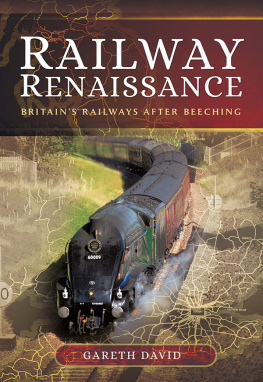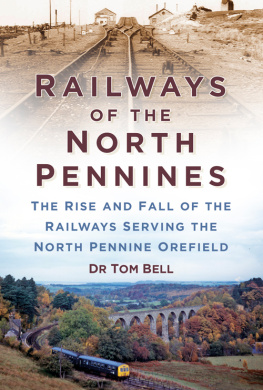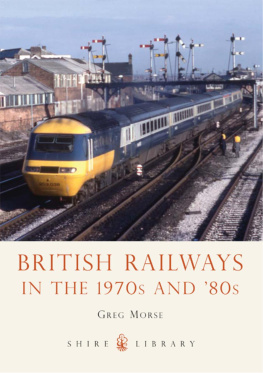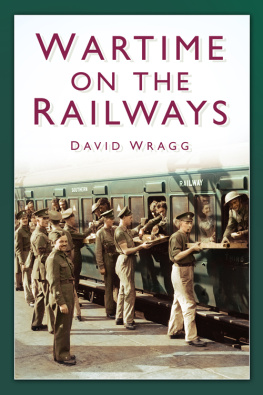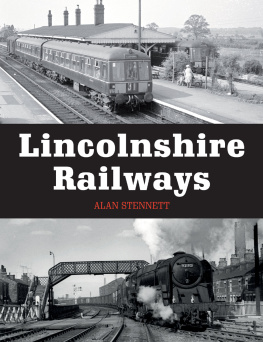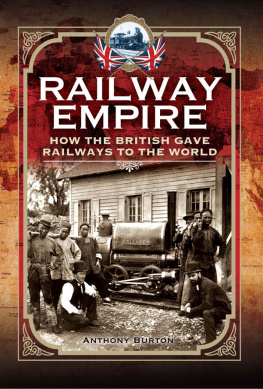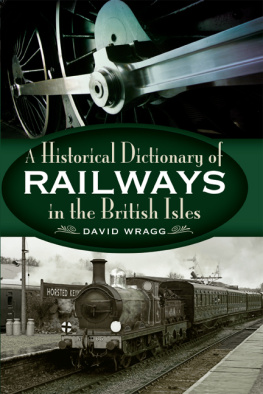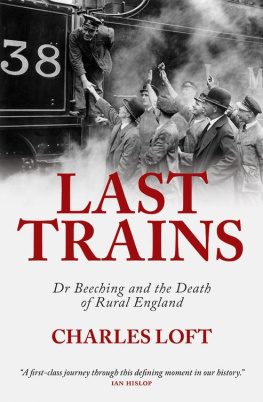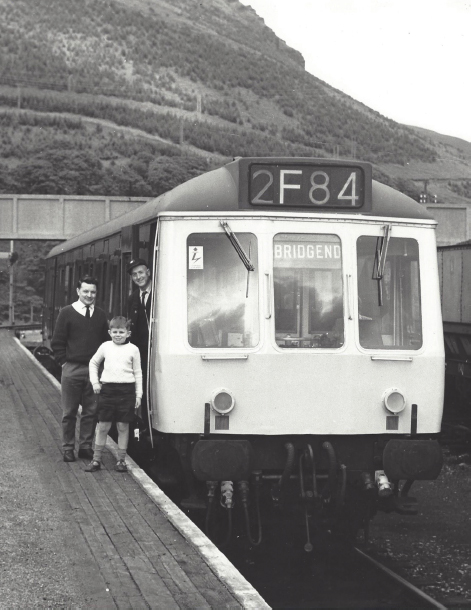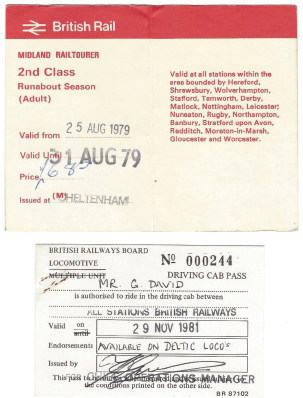
RAILWAY RENAISSANCE
In Memory of Trefor David (19301999)
Inspiration for my life-long interest in railways
Cymmer Afan had become the temporary terminus for trains from Bridgend and Maesteg, following closure of the Rhondda Tunnel and the link to Treherbert in 1968. Shortly before closure in 1970, the author stands alongside a Class 121 bubble car with his late father, Trefor, and an unknown driver. Photo: Derek Short
RAILWAY RENAISSANCE
Britains railways after Beeching
Gareth David
First published in Great Britain in 2017 by
Pen & Sword Transport
an imprint of
Pen & Sword Books Ltd
47 Church Street
Barnsley
South Yorkshire
S70 2AS
Copyright Gareth David 2017
ISBN 978 1 47386 200 5
eISBN 978 1 47386 202 9
Mobi ISBN 978 1 47386 201 2
The right of Gareth David to be identified as the Author of this Work has been asserted by him in accordance with the Copyright, Designs and Patents Act 1988.
A CIP catalogue record for this book is available from the British Library
All rights reserved. No part of this book may be reproduced or transmitted in any form or by any means, electronic or mechanical including photocopying, recording or by any information storage and retrieval system, without permission from the Publisher in writing.
Pen & Sword Books Ltd incorporates the imprints of Pen & Sword
Archaeology, Atlas, Aviation, Battleground, Discovery, Family History,
History, Maritime, Military, Naval, Politics, Railways, Select, Transport,
True Crime, Fiction, Frontline Books, Leo Cooper, Praetorian Press, Seaforth
Publishing and Wharncliffe.
For a complete list of Pen & Sword titles please contact
PEN & SWORD BOOKS LIMITED
47 Church Street, Barnsley, South Yorkshire, S70 2AS, England
E-mail:
Website: www.pen-and-sword.co.uk
Gareth David developed his life-long interest in railways while growing up in Cheltenham Spa during the 1960s and early 1970s, then moved to London, where he read Modern History at University College (UCL). On graduating in 1979 he trained as a journalist, before joining The Times as Stock Market Reporter in early 1982. He went on to work on the business section of The Observer and later The Sunday Times , where he was Deputy City Editor from 198890. A highlight of his subsequent career in public relations consultancy was to support Ian Yeowart for 12 years in battling to launch Open Access operator Grand Central Railway Company.
Gareth now lives at Haslemere in Surrey and has been a commuter to Waterloo for nearly 25 years. He is married, with four grown-up children, and spends some of his limited spare time working as a volunteer booking clerk or buffet car steward on the Mid-Hants Railway (Watercress Line). To learn more, please visit www.railwayworld.net
INTRODUCTION
H alf a century ago, on the morning of Sunday 2 July 1967, a small boy stands beside the railway line on the south side of Basingstoke station, opposite the shed where a few steam locomotives stand in idle silence, awaiting their final days in service and then the cutters torch. It is the last week of steam in southern England and the boy and his father are there to witness a commemoration of this sad day. There had been plans to run no less than five steam specials from London to Bournemouth to mark the end of Southern Region steam, but the fare of 4 return to Bournemouth from Waterloo (equivalent to 67.25 today) had put many enthusiasts off, with the result that only two of the five were run, hauled respectively by Merchant Navy Class locos 35008 Orient Line and 35028 Clan Line . The Bournemouth Belle , another victim of electrification, was hauled that day by a Brush Type 4 (later Class 47) diesel, but there was one other steam special, hauled on its outward journey by West Country Class 34025 Whimple .
Move ahead just over a year and that same small boy and his father are standing outside Moses Gate station near Bolton on the afternoon of Sunday 11 August 1968. The father has a tear in his eyes as Class 5 locos 44781 and 44871 come into view, heading the Carlisle to Manchester leg of the famous 15 Guinea Special this time it really is the end of steam on the whole of British Railways. Witnessing this sad day for father and son had followed a couple of trips from Cheltenham to Preston in early summer 1968 to experience the last outpost of British steam working including a last ever steam-hauled trip on BR from Preston to Kirkham on a service for Blackpool and visits to the last remaining steam sheds in the area, nearby Lostock Hall (shed-code 10D), as well as Springs Branch, Wigan (8F) and Speke Junction in Warrington (8C)
For many August 1968 was a black time in the history of our railways. Steam was at an end and the spate of closures initiated by the 1963 Beeching Report was at its peak 300 miles of line were closed in 1967 and a further 400 miles in 1968. Widespread motorway construction threatened to marginalise what would remain of the national network, which had long been starved of investment. As that small boy who had been at Basingstoke and Moses Gate, it was an inauspicious time to be developing a lifelong passion for railways, but trainspotting ran in the family, and if I were to be deprived of seeing any more Merchant Navys, Jubilees or Britannias in action then the first generation of diesel the Peaks, Warships, the Westerns and Deltics would have to do.
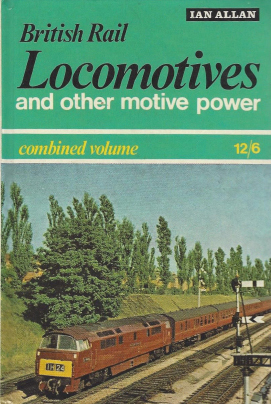
The 1968 Ian Allan ABC was my first spotting bible and last in this famous series to have steam locomotives at the front. Besides the three Vale of Rheidol narrow gauge locomotives, it lists a total of 430 steam locomotives that were still in service (all confined to northwest England), based on numbers checked to 2 December 1967. The cover photo is of now-preserved Class 52 D1062 Western Courier approaching Acocks Green near Birmingham on 11 June 1963.
Two memorable souvenirs from the trainspotting years: a Midland Railtourer ticket and a footplate pass, arranged for me by Tom Greaves, a legendary figure in BR management at the time and friend of my late father. Note Toms endorsement which secured me a trip from York to Kings Cross in the cab of D9021 Argyll and Sutherland Highlander .
So began a life-long interest in all things railway a journey that has taken me to every corner of Great Britain and places abroad stretching from Albania to Zimbabwe. Besides unforgettable footplate experiences on steam locomotives in Poland and Zimbabwe, notable milestones along the way were a cab ride in one of the last Deltics from York to London (1981), being arrested in Poland for photographing an Ol49-class steam locomotive on a passenger train at Sierpc (1990), leading a successful campaign to save buffet cars on the WaterlooPortsmouth Line (1996) and being a founder director of Grand Central Railway Company at the time it launched services from Sunderland to London in 2007.
But for all the many facets of my railway interest, one that really captures my imagination is that of railway re-openings. Lines and stations that fell under the Beeching axe, and others that had closed even before the Doctor did his worst, but have been resurrected decades later and have successfully brought rail services back to places as far afield as Alloa and Galashiels in Scotland, Aberdare and Ebbw Vale in Wales, Mansfield and Melksham in England.
Next page
